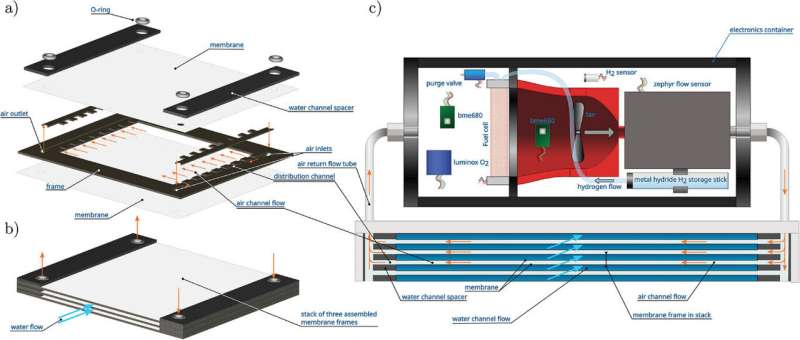Artificial gills for ocean gliders: A new energy system for autonomous underwater vehicles
Autonomous underwater robots, such as ocean gliders, can autonomously navigate the ocean for several weeks. Their sensors measure parameters like temperature, pressure, salinity, oxygen concentration, and currents. Capable of diving to depths of up to 1,000 meters, they facilitate measurements that are challenging to achieve with research vessels.
Additionally, gliders can be operated at a much lower costs than research vessels. However, lithium batteries pose challenges for research teams. Classified as hazardous materials, they can only be transported under strict safety regulations, complicating logistics and increasing project costs.
To address this issue, scientists at the Helmholtz-Zentrum Hereon have developed a new energy system. With hydrogen as an energy source, it is significantly more sustainable than lithium batteries and enables a greater range for ocean gliders. Its unique feature employs membrane technology—it extracts oxygen from seawater, much like a fish’s gills.
Nature as inspiration
Dr. Lucas Merckelbach and Dr. Prokopios Georgopanos from the Helmholtz-Zentrum Hereon propose powering gliders with a fuel cell that generates electricity from hydrogen and oxygen. A glider can then be filled up with hydrogen at the deployment site. A container with metal hydrides serves as a safe and efficient storage medium.
These hydrides store hydrogen by bonding hydrogen to the metal hydrides at the atomic level. Oxygen, on the other hand, is not stored but extracted directly from seawater. “Nature is a great source of inspiration for us,” says Merckelbach. He works at the Institute of Coastal Ocean Dynamics and uses ocean gliders in his own research.
The concept was developed by Merckelbach in collaboration with Georgopanos from the Institute of Membrane Research. Georgopanos identified an oxygen-permeable silicone membrane that functions as artificial gills when integrated into the glider’s hull.
Exposed to oxygen-rich seawater on the outside, the membrane enables oxygen to diffuse into an internal recirculating airflow. The fuel cell then extracts oxygen from this airflow, where it reacts with hydrogen to generate electrical energy.

Greater range and sustainability
“This system eliminates the need for onboard oxygen storage. The weight and volume saved can be used for additional hydrogen storage, enabling higher energy density and lower operating costs compared to current battery solutions,” explains Georgopanos. This would allow the gliders to operate for longer periods. Furthermore, hydrogen is a more sustainable energy source than batteries.
Georgopanos and Merckelbach have already patented their new energy system. In their paper, “A Fuel Cell Power Supply System Equipped with Artificial Gill Membranes for Underwater Applications,” they present their first prototype. The paper was recently published in the journal Advanced Science.
Over the coming years, they will further optimize the system as part of the MUSE project. Hereon will strengthen its teams at the Institutes of Membrane Research and Hydrogen Technology for this effort. MUSE is a collaborative project with the Alfred Wegener Institute, Helmholtz Center for Polar and Marine Research (AWI) in Bremerhaven, and GEOMAR Helmholtz Center for Ocean Research Kiel, aiming to advance marine technology and infrastructure.
“This interdisciplinary work combines knowledge from coastal research, membrane research, and hydrogen technology—a rare combination, but one that exists at Hereon,” says Georgopanos.
More information:
Lucas Merckelbach et al, A Fuel Cell Power Supply System Equipped with Artificial Gill Membranes for Underwater Applications, Advanced Science (2025). DOI: 10.1002/advs.202410358
Helmholtz Association of German Research Centres
Citation:
Artificial gills for ocean gliders: A new energy system for autonomous underwater vehicles (2025, January 16)
retrieved 17 January 2025
from https://techxplore.com/news/2025-01-artificial-gills-ocean-gliders-energy.html
This document is subject to copyright. Apart from any fair dealing for the purpose of private study or research, no
part may be reproduced without the written permission. The content is provided for information purposes only.

Comments are closed